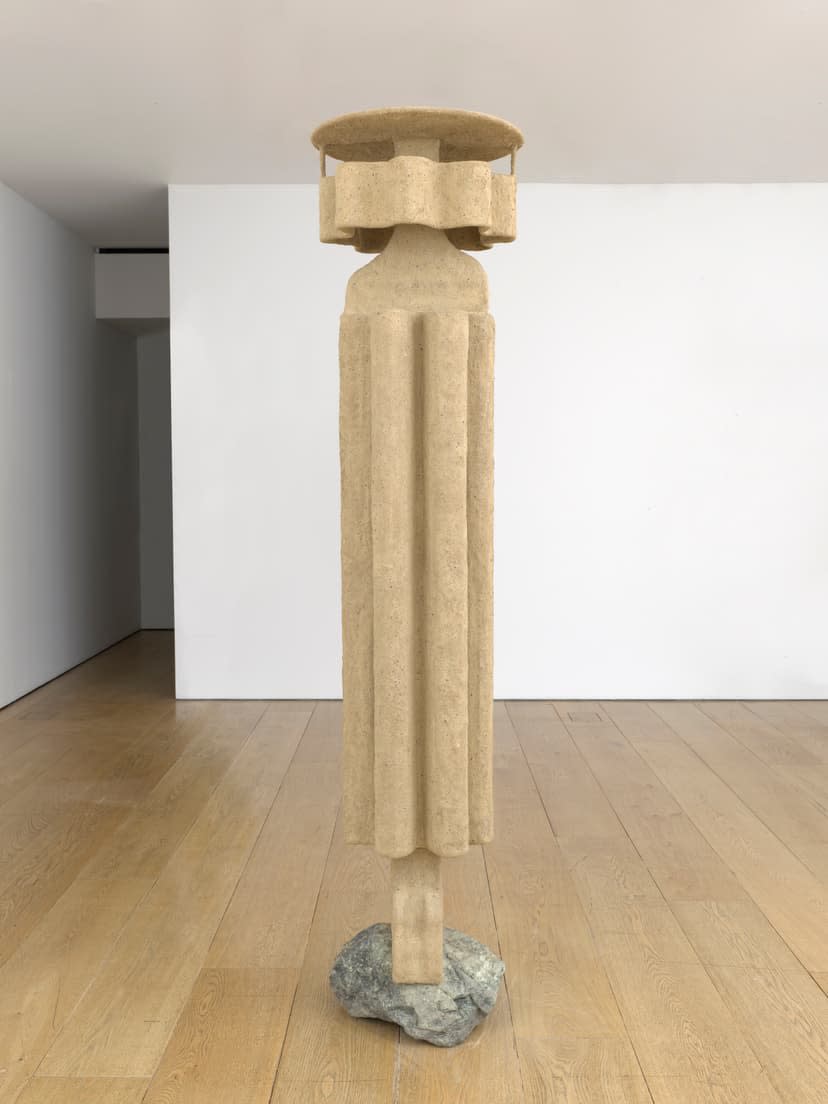12 October 2024 Where is the body? There is a scrolling headless torso locked in a frame on a hook-up app. A marble god is erected over a pedestal in a Florence street corner. You might as well be looking at an AI-generated faux Jake Gyllenhaal on Instagram, removing his sock to your face. Or, simply, a nude back could be bulkily reclined—flesh and bone—aside you in bed. For the wandering eye, the way reality unfolds today renders the body everywhere and nowhere, online and off. A hefty challenge for artists, it seems, is to conjure physicality in various cases of its material absence and assure that the viewer’s eye still feels tantalized and skin almost touched.
A corporal likeness is amiss in the five sculptures (all 2024 if not noted) at Oren Pinhassi’s show, Losing Face. However, in the display at Lehmann Maupin’s basement gallery, a yearning for it is commonplace. The body’s erasure builds its own tactile abundance across the totemic figures which are all made with steel, sand, and burlap. They each perch on a piece of rock with a singular foot—more so of a feline paw—affixed onto the bumpy mount. Like suffering a punishment, they are devoted to their vertical stillness. Pleasure might be harder to notice owing to Pinhassi’s economic references for play. Yet, the show’s titular work winks at glory holes—even a circle jerk—with its tens of punctures in a grid formation. Blind Spot II (2023) demands a kinkier imagination to unveil its intentions. A column of tilted vents are crowned with a triangular hollow roof—besides the air’s penetration, the blinds also hold a potential of entry for the voyeurist gaze. Their angular surfaces however limit what stays visible beyond: the unseen remains teased.

Oren Pinhassi, Mourner no.3 (Night Shower), 2024, steel, sand, burlap, polymer and rock, 96 x 22 x 22 inches. Courtesy the artist, Edel Assanti, London and Lehmann Maupin, New York, Seoul, and London.
The army of hinted desires occupies the subterranean room like ages-old remnants fresh off excavation. Their peculiar forms grant them timelessness. Pinhassi commits to a secretive vocabulary which makes a narrative climax tougher to settle onto, and indeed, the New York-based artist’s work revels in this reticent charm. Sexy echoes through the earthy-toned sculptures with a flakiness that comes and goes across Pinhassi’s firm, even architectural, creations. Larger than us, they tower in their alien statures and odd roles. Mourners no.3 (Night Shower), for example, recalls a solemn wanderer of the night, doing their time of agony. A shrouded coat and a dramatically-round hat are the likeliest sartorial details one can attribute to their nocturnal pilgrimage.
Orifices are peppered around each non-body, as well as curves, inlays, and piles. Rough and raw, their skins are both firmly sealed and somewhat malleable as if they were still vulnerable to being molded. Process, albeit the hand’s intrusion, is detectable on their skin. Sand gives the surface a desirable and repulsive finish: begging for touch, the coarse outer layers would unforgivingly chafe the rubbing hand. The artist builds its case on this duality of the immediate and the suggested. Harsh skin and airy sand blend with rough fantasies and demure bearings.
Pinhassi attributes a playful array of bodily possibilities in his vertical formations. Like lovers in bed for the first time, carnal surprises emerge from his visual palette. Truth Teller is a tree of globular growths that emerge from a thin root. Their floral burgeoning and virus-like swelling is both botanical and biological. There is something also comical about this sculpture, partially through the bulbous piles’ quirky silhouette, as well as a resemblance to a body helplessly losing its semblance.

